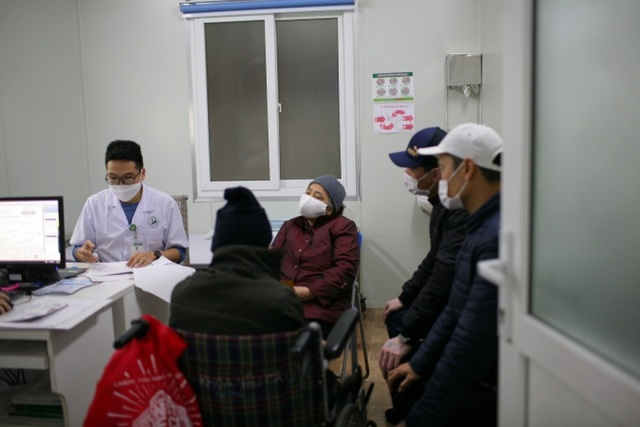Post-COVID-19: Many people have a long dry cough, shortness of breath, hair loss, and loss of concentration
Since the Lunar New Year until now, the number of patients infected with COVID-19 growing quickly. The majority of COVID-19 patients who are monitored for treatment recover from the disease, but then develop symptoms lasting several weeks to several months, in some cases leaving severe sequelae.
Short of breath, difficult to breathe
Mr. Nguyen Hai A. (36 years old, Hanoi) was infected with COVID-19 from January 12 and was determined to be cured on January 21. During the acute phase of COVID-19 infection, he only had mild symptoms of nasal discharge and body aches.
By the time he was infected with COVID-19 nearly 1 month, he was short of breath when speaking long sentences and felt short of breath when walking quickly. He went to the respiratory clinic, Bach Mai Hospital. Through examination, imaging and assessment of respiratory function, he was diagnosed with interstitial lung damage, possibly related to COVID-19 with limited ventilation disorder.
In addition to being prescribed medication, he was instructed by the doctor to practice breathing and exercise to restore respiratory function and physical strength.
Mr. Do Xuan T. who has recovered from COVID-19 for 2 weeks now also shared that he is still often tormented by coughs and always feels tired in his body. Not only that, he also found himself with memory loss, loss of concentration when working.
Post-COVID-19 symptoms like Mr. Nguyen Hai A and Mr. Do Xuan T are not uncommon. Therefore, it is necessary to closely monitor your own abnormal expressions, not to be subjective.

The patient came for a post-COVID-19 examination at Duc Giang General Hospital (Hanoi).
The common symptoms after COVID-19 infection manifest in multiple organs, in which respiratory manifestations are common. Some studies show that a persistent dry cough, shortness of breath, and shortness of breath are persistent and common symptoms, with an incidence of 42-66% within 3 months of illness.
In addition, after the acute phase of COVID-19, 25% of patients reduced their physical activity by having a 6-minute walking distance lower than the normal reference value. 50-60% of the following patients with COVID-19 with persistent respiratory symptoms are examined by X-ray or computed tomography of the chest with lesions. The most common lesions are opacities, pulmonary fibrosis, tissue pneumonia, thickening of the interlobular septum, emphysema, etc. These abnormalities can be missed on plain chest X-ray films. often.
In addition to respiratory symptoms such as prolonged dry cough, cough with sputum, sore throat, shortness of breath, shortness of breath, chest pain, the patient may have gastrointestinal symptoms including nausea, vomiting, and epigastric pain. , digestive disorders; on mental health persistent fatigue, sleep disturbances, insomnia, anxiety, decreased concentration, emotional disturbances; Neurological manifestations include headache, dizziness, loss of taste, loss of smell, memory loss (brain fog), …
Assoc. Prof. Dr. Phan Thu Phuong, Director of the Respiratory Center, Bach Mai Hospital, said, “Long-term COVID-19 syndrome” or “post-COVID-19 syndrome” manifests in a variety of ways and can be encountered in many organs. organs on the body. The groups of abnormal symptoms according to specialties need to be examined and evaluated for severity, and other causes should be excluded before concluding post-COVID-19 syndrome.
High-risk patients for post-COVID-19 syndrome include: People over 60 years of age, with comorbidities such as hypertension, diabetes, chronic obstructive pulmonary disease, asthma, chronic kidney disease, disease Chronic liver disease, chronic blood disease, cancer, immunodeficiency…, patients with indications for home oxygen therapy, especially the group of critically ill patients requiring ventilatory support during COVID-19 and people who have not received the full dose of the basic COVID-19 vaccine.
How to monitor health?
Assoc. Prof. Dr. Phan Thu Phuong shared, to prevent post-COVID-19 sequelae, it is necessary to vaccinate to prevent infection. If unfortunately becomes F0, the patient needs to comply with the local medical declaration to be managed and stratified with levels from asymptomatic to mild, moderate and severe.
If you detect any one of the signs such as difficulty breathing, shortness of breath, or in children, there are signs of abnormal breathing, you must immediately notify the facility managing people with COVID-19 at home; commune and ward health stations; or mobile medical station, emergency transportation center… for emergency treatment and timely hospital transfer. Abnormal signs in children such as groaning, chest indrawing, rising and falling nostrils, wheezing, stridor; respiratory rate in adults ≥ 20 breaths/minute; SpO2 ≤ 96%; tachycardia > 120 beats/min or < 50 beats/min; low blood pressure: systolic blood pressure < 90 mmHg, diastolic blood pressure < 60 mmHg (if measurable); frequent chest pain, feeling of tightness in the chest, pain that increases when taking a deep breath; altered consciousness: confusion, narcolepsy, lethargy, very tired/exhausted…
In addition, when there are any health abnormalities after being infected with COVID-19, the patient should go to a medical facility for examination or contact medical staff for advice and support, in order to detect early symptoms. sequelae, complications, acquired diseases for timely and effective treatment.
Assoc. Prof. TS.BS Hoang Thi Phuong, Senior Lecturer, Vice Dean of Internal Medicine, University of Medicine and Pharmacy (Hanoi National University), noted that post-COVID is a health issue that people are concerned and worried about. , especially patients who have just recovered from illness. Therefore, after contracting COVID-19, people should visit and check their health at medical facilities to monitor and evaluate their comprehensive health status.
If there are respiratory symptoms in the post-COVID-19 syndrome (difficulty breathing, persistent cough, chest pain, impaired respiratory function, limited physical activity, …) Medical care will help early detection and early treatment of pulmonary sequelae after COVID-19.
In addition, units need a comprehensive approach strategy for assessment and care of patients’ post-COVID-19 status as well as multi-specialist coordination in the management, treatment and monitoring of post-infected patients. COVID due to multi-organ damage. In particular, attention should be paid to rehabilitation as soon as possible and appropriate.

Understanding COVID-19 re-infection with natural immunity and vaccination
VOV.VN – After being infected with COVID-19, the body will generate immunity, but not all immunity is sustainable because there is always a decrease in antibodies in the blood, leading to the risk of re-infection with anyone. .
* Invite readers to watch the programs broadcast by Vietnam Television on TV Online and VTVGo!
at Blogtuan.info – Source: vtv.vn – Read the original article here



